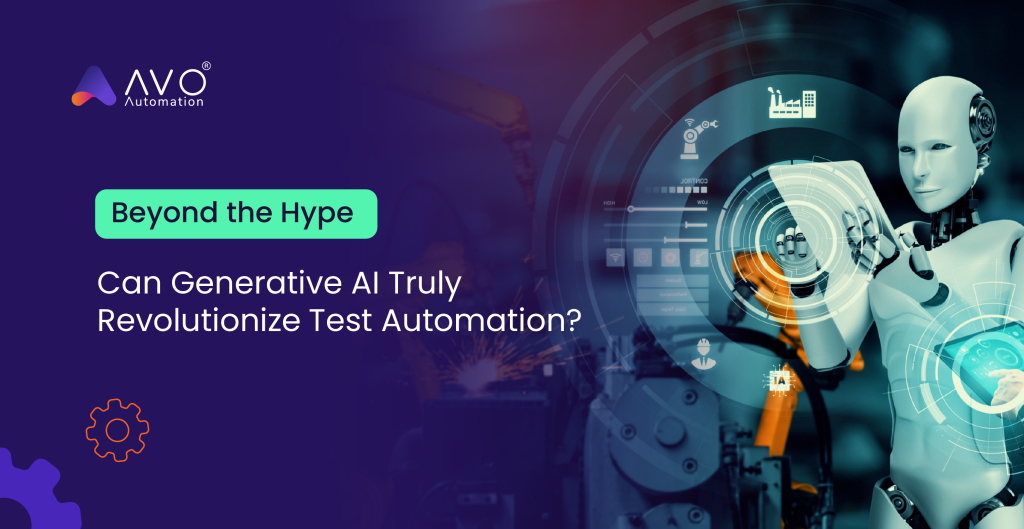The surge of generative AI has captured the imagination of industries worldwide, promising to revolutionize workflows, optimize processes, and unlock unparalleled efficiencies. Among the sectors poised for disruption, test automation stands out as a fertile ground for AI-powered transformation. But beyond the buzzwords and lofty promises, how much of this is tangible, and how much is hype?
Let’s explore whether generative AI can genuinely revolutionize test automation, backed by trends, statistics, and debunked myths.
The Evolution of Test Automation: A Brief Context
Initially, software testing was a labour-intensive manual process. Over time, tools like Selenium and Appium introduced scripted automation, which allowed repeatable and consistent testing. However, these methods still required significant manual intervention for scripting and maintenance.
Unlike traditional automation, which relies on predefined scripts, generative AI leverages advanced machine learning models to analyze vast datasets, identify patterns, and autonomously generate test cases, scenarios, and even code snippets. This capability marks a significant leap in the evolution of test automation.
What is Generative AI in Test Automation?
Generative AI refers to AI models capable of producing new, human-like content, whether it’s text, images, or even code. Applied to test automation, generative AI can:
- Create test cases based on user requirements or system specifications.
Generative AI can analyze code, specifications, and user behavior to generate test cases covering diverse scenarios. This capability significantly reduces manual effort and enhances test coverage.
- Automate bug fixes by analyzing application behavior
AI models excel at analyzing logs, code, and execution traces, identifying anomalies that may go unnoticed by human testers. Companies like Google’s DeepMind have leveraged AI to optimize and enhance their testing processes.
- Generate test data based that mimic real world data patterns
Generative AI tools can detect UI or code changes and automatically update test scripts to adapt to these changes. This eliminates the repetitive manual updates often required after software modifications.
- Analyze test results to provide actionable insights faster than traditional tools.
AI can analyze historical bug data to predict high-risk areas, allowing testers to focus their efforts strategically. This ensures that critical functionalities receive the attention they deserve.
Myths and Facts About Generative AI in Test Automation
Myth 1: Generative AI Replaces Test Engineers
Fact: Generative AI amplifies the capabilities of test engineers rather than replacing them.
- A McKinsey study highlights that 60% of all occupations could see 30% of their tasks automated, but roles like test engineering will require human oversight for critical decision-making and creative problem-solving.
Myth 2: Generative AI Can Fully Automate All Tests
Fact: Generative AI excels in automating repetitive tasks but struggles with context-sensitive scenarios such as exploratory testing.
- Stat: According to Gartner, by 2025, 70% of organizations will integrate AI-driven testing tools, but these tools will complement rather than replace manual testing.
Key Trends: Generative AI in Test Automation
1. AI-Powered Test Case Generation
Generative AI can produce test cases based on application flow, user behavior, and edge cases. Tools like OpenAI’s Codex are being adapted for such purposes, significantly reducing the time needed for test case creation.
- Example: Companies like Avo Automation are integrating generative AI for smarter test generation.
- Stat: Test creation time can be reduced by up to 40%, according to a report by Capgemini.
2. Smarter Test Data Creation
Generative AI creates synthetic yet realistic test data, ensuring better coverage without compromising sensitive user information.
- Fact: The global synthetic data generation market is projected to grow at a 4% CAGR between 2023 and 2030.
3. Intelligent Defect Prediction and Prevention
Generative AI leverages historical data to identify potential defects even before they occur. This proactive approach enhances quality and reduces costs.
- Stat: Defect detection rates increase by up to 50% with AI-powered tools, as noted in an IBM report.
4. Accelerated Test Execution and Maintenance
AI can autonomously adjust test scripts to accommodate application updates, minimizing downtime caused by broken scripts.
- Fact: Maintenance costs for automated testing can drop by 25%-30% with generative AI integration, per Forrester Research.
Validations: Does Generative AI Deliver on Its Promises?
Real-World Applications
- Facebook’s Infer tool uses AI for bug detection, achieving more robust software quality. https://engineering.fb.com/2015/06/11/developer-tools/open-sourcing-facebook-infer-identify-bugs-before-you-ship/
Similarly, companies leveraging generative AI report:
- Significant reduction in regression testing time.
- Faster time-to-market with improved quality assurance.
- Netflix: Uses AI to simulate millions of user scenarios, ensuring seamless streaming.
- Salesforce: Employs generative AI for test data generation, reducing manual efforts by over 35%.
ROI Insights
- Organizations using AI-driven testing tools report a 20-40% reduction in time-to-market, according to Deloitte.
- Test coverage expands by 30%, enabling more robust software releases.
The Benefits: Quantifying the Impact
- Improved Test Coverage: Generative AI ensures >95% test coverage by exploring edge cases and unexpected scenarios.
- Increased Productivity: Automated test generation boosts productivity by up to 4x, freeing up QA teams for strategic tasks.
- Accelerated Launches: By reducing manual effort, businesses can expedite product launches 7x faster.
- Cost Efficiency: Companies like Facebook report significant cost savings through AI-enhanced bug detection and resolution.
The Challenges: Where Does Generative AI Fall Short?
- Lack of Contextual Understanding
While generative AI generates numerous test cases, it often lacks the nuanced understanding of human testers. This can result in irrelevant or low-value tests.
- Computational Demands
Training and running advanced AI models require substantial computational resources, posing challenges for smaller organizations.
- Ethical Concerns
Issues such as bias in AI-generated tests and data privacy need to be carefully managed to ensure fairness and compliance.
- Resistance to Adoption
Integrating generative AI into existing workflows may face resistance due to skill gaps and the need for redefined processes.
The Limitations of Generative AI in Test Automation
While the potential is enormous, generative AI is not without its challenges:
- Context Awareness: AI struggles with understanding complex application nuances, which requires human input.
- Ethical Concerns: Misuse of AI for generating malicious scripts or compromising data integrity remains a risk.
- High Initial Investment: Implementing generative AI solutions can be cost-prohibitive for smaller businesses.
While generative AI offers tremendous potential, ethical considerations are paramount. Ensuring data privacy, addressing biases, and maintaining human oversight are essential for sustainable adoption. Organizations must strike a balance between automation and human expertise to achieve the best outcomes.
Future Trends in Generative AI for Test Automation
- Adaptive Testing Systems: Generative AI models will evolve to adjust dynamically to changing application requirements.
- Visual Testing Enhancements: AI will increasingly focus on UI/UX testing, identifying visual inconsistencies across devices and platforms.
- Broader Accessibility: No-code or low-code AI testing tools will enable non-technical stakeholders to contribute meaningfully to testing efforts.
Avo Assure’s GenAI Capabilities: Transforming Test Automation
Avo Assure’s no-code automation platform stands at the forefront of integrating generative AI into test automation. With its cutting-edge features, Avo Assure ensures seamless and efficient testing processes. Delve into Avo’s GenAI capabilities here: https://avoautomation.ai/blog/introducing-avo-genai-revolutionizing-software-testing-with-ai-approach/
Learn how to future-proof QA with Avo’s GenAI capabilities here: https://avoautomation.ai/blog/future-proofing-qa-embracing-gen-ai-with-avo-assure/
Discover more about Avo Assure’s capabilities on https://avoautomation.ai/.
With tools like Avo Assure, businesses can harness the full potential of AI while addressing its limitations responsibly. The future of testing is here—and it’s powered by collaboration between humans and intelligent machines.

